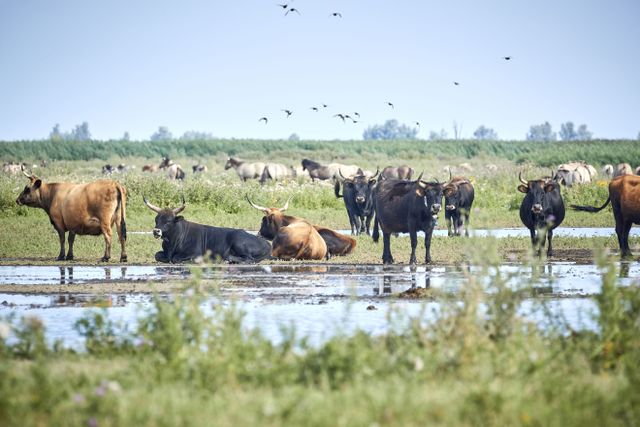Het Steile Zand
Just a wingspan away from Amsterdam, between Almere and Lelystad, lies a vast and surprising natural area: Nieuw Land National Park. A varied, water-rich landscape that is constantly changing. Space for young delta nature forms the foundation for a true bird paradise: rare bird species feel at home here, and species that once disappeared from the Netherlands have returned. Nieuw Land National Park tells the typical story of land reclaimed from water, how the impoldering of the Zuiderzee created both new land and new nature. No other national park in or outside the Netherlands tells such a story.
Every visit is different, but always an experience.
Management
Oostvaardersplassen
From the Praambult lookout, you have a stunning view over the ‘dry part’ of the Oostvaardersplassen. The Oostvaardersplassen area covers around 2,000 hectares and consists of wet and dry grasslands, woodland-meadow landscapes, reed beds, rough terrain, and open water. This varied landscape is maintained through water level management and grazing by large herbivores: heck cattle, konik horses, and red deer. This helps prevent the grasslands from becoming forest, which would be detrimental for many bird species that rely on these wet and dry grasslands. In winter, thousands of barnacle geese migrate to the Oostvaardersplassen to feast on protein-rich grass. In summer, the area is dominated by birds that prefer reed beds and low vegetation, such as the bluethroat, reed warbler, sedge warbler, and Cetti’s warbler. The wet grasslands near the marshes provide a rich feeding ground for migratory birds in spring and autumn. Many species of ducks and waders easily find food in the muddy shallows. And year-round, you might be surprised by a soaring white-tailed eagle.

Always surprising
Dynamic wetlands
Much of the nature in Nationaal Park Nieuw Land consists of wetlands, Flevoland’s “wetlands,” where land and water continuously interact. This dynamic relationship creates rich natural habitats where many plant and animal species – especially birds – thrive. By monitoring nature development and conducting research, Nationaal Park Nieuw Land gains valuable insights into the functioning of wetlands and how we as humans can support nature. One example is the marsh reset in the Oostvaardersplassen, an artificial lowering of the water level in the Grote Plas to allow new reed growth and other vegetation that birds favor. Once recovery has progressed far enough, the water level is gradually raised again. Thanks to the ever-changing water levels, returning visitors to Nieuw Land are treated to ever-changing nature experiences: shifting landscapes, newly formed islands, and herds of heck cattle and konik horses roaming through the rough terrain in search of food. The nature in the park is never the same, let it surprise you every season!

National Park
A unique part of the Dutch system of national parks
Nationaal Park Nieuw Land was granted national park status in 2018. It is one of the youngest and, at around 29,000 hectares, also one of the largest national parks in the Netherlands. The park is made up of four areas: the Oostvaardersplassen, the Lepelaarplassen, part of the Markermeer, and the Marker Wadden island group. Its nature and landscapes are unique in the Netherlands, partly due to their origins, and contribute to nature conservation on both a national and international scale. With its national park status, Nieuw Land is part of the Dutch national park system.

Breathtaking
White-tailed eagle
Since 2006, the white-tailed eagle has been breeding again in the Netherlands. After being absent for hundreds of years as a breeding bird, a pair of white-tailed eagles found a suitable place to build a nest in the vast marshes of the Oostvaardersplassen. Since their return to the Oostvaardersplassen, the number of breeding pairs has spread across the country. In 2024, 40 breeding pairs were observed in the Netherlands, and this impressive bird is becoming an increasingly common sight. A resident pair breeds in the Oostvaardersplassen area every year. Young white-tailed eagles often visit the area, and it’s not uncommon to see several of them together around a prey in the field. Perhaps they’re making plans for the future – finding a partner and starting a new family here.
The Oostvaardersplassen are popular with white-tailed eagles because the area offers peace and an abundant buffet nearby. Whether it’s a large carp, a barnacle goose, a coot, or a deer carcass – there is plenty to eat year-round.
The white-tailed eagle is the largest bird of prey in the Netherlands, with a wingspan of 2.40 meters. In flight, it’s easy to recognize by its rectangular shape (like a “flying door”) and slow wingbeats. Adults have a white tail – hence the English name “white-tailed eagle.”
